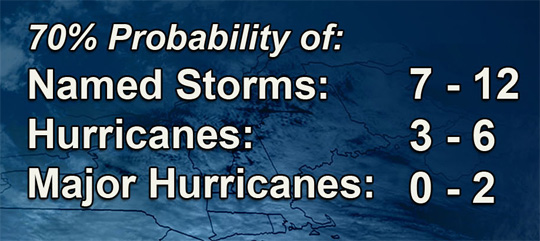NOAA Calls For Increased Chance Of Below Normal Hurricane Season
August 8, 2014
Forecasters with NOAA’s Climate Prediction Center raised the likelihood for a below-normal season in an update released Thursday to the Atlantic Hurricane Season Outlook.
The update predicts a 70 percent chance of a below-normal season, a 25 percent chance of a near-normal season and only a five percent chance of an above-normal season. The probabilities in the initial outlook issued on May 22 were 50 percent, 40 percent and 10 percent, respectively.
 “We are more confident that a below-normal season will occur because atmospheric and oceanic conditions that suppress cyclone formation have developed and will persist through the season,” said Gerry Bell, Ph.D., lead seasonal hurricane forecaster at NOAA’s Climate Prediction Center, a division of the National Weather Service.
“We are more confident that a below-normal season will occur because atmospheric and oceanic conditions that suppress cyclone formation have developed and will persist through the season,” said Gerry Bell, Ph.D., lead seasonal hurricane forecaster at NOAA’s Climate Prediction Center, a division of the National Weather Service.
“Nonetheless, tropical storms and hurricanes can strike the U.S. during below-normal seasons, as we have already seen this year when Arthur made landfall in North Carolina as a category-2 hurricane. We urge everyone to remain prepared and be on alert throughout the season.”
The primary factors influencing the increased chance of a below-normal season are:
- Overall atmospheric conditions are not favorable for storm development. This includes strong vertical wind shear, a weaker West African monsoon, and the combination of increased atmospheric stability and sinking motion. These conditions mean fewer tropical systems are spawned off the African coast, and those that do form are less likely to become hurricanes. These conditions are stronger than originally predicted in May and are expected to last mid-August through October, the peak months of the hurricane season;
- Overall oceanic conditions are not favorable for storm development. This includes below-average temperatures across the Tropical Atlantic, which are exceptionally cool relative to the remainder of the global Tropics. This cooling is even stronger than models predicted in May and is expected to persist through the hurricane season; and
- El Niño is still likely to develop and to suppress storm development by increasing vertical wind shear, stability and sinking motion in the atmosphere.
The updated hurricane season outlook, which includes the activity to-date of hurricanes Arthur and Bertha, predicts a 70 percent chance of the following ranges: 7 to 12 named storms (top winds of 39 mph or higher), including 3 to 6 hurricanes (top winds of 74 mph or higher), of which 0 to 2 could become major hurricanes (Category 3, 4, 5; winds of at least 111 mph).
These ranges are centered below the 30-year seasonal averages of 12 named storms, six hurricanes and three major hurricanes. The initial outlook in May predicted 8 to 13 named storms, 3 to 6 hurricanes and 1 to 2 major hurricanes.
The Atlantic hurricane region comprises the North Atlantic Ocean, the Gulf of Mexico and the Caribbean Sea. NOAA’s seasonal hurricane outlook is not a hurricane landfall forecast; it does not predict how many storms will hit land or where a storm will strike.




Comments